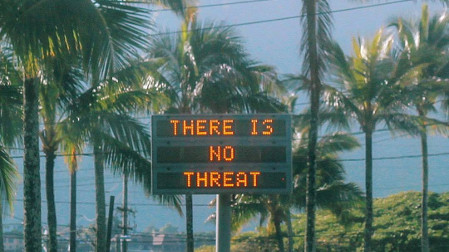Hawaii False Alarm Illustrates Importance of EAS
WASHINGTON—The former head of Federal Emergency Management Agency says the recent false missile warning incident in Hawaii provides an opportunity for local and federal government agencies to review their emergency alerting systems and also said that the event illustrated the important role television and radio broadcasters play during emergencies.

In a column on Morning Consult, Craig Fugate, who was FEMA administrator during the Obama administration, said the incident raised important questions about the nation’s emergency alerting system, but added that “this incident also offers an opportunity for everyone to review their own emergency preparedness plans.”
He also pointed out the importance of having “trustworthy sources of information,” during such emergencies. “During times of crisis, the public’s best source for information is a communications network that has kept people safe for decades—their local broadcaster,” he wrote.
He added that broadcasters were among the first to alert the public that the missile warning was a mistake. “Many stations were able to confirm on air that it was a false alarm just minutes after the initial alert, well before public safety officials passed that news to the public,” he wrote.
Acknowledging the reality that more and more citizens get their news and information from wireless devices now, Fugate noted the importance of smartphone apps like NextRadio that allow listeners to listen to live local radio stations over cellular. He singled out Apple for remaining a holdout in the effort to activate radio enabled chipsets in its iPhones. “At a time when the public needs access to more information—not less—Apple should to the right thing and voluntarily unlock radio chips in iPhones,” he wrote.
He also noted the significance of the Next Gen TV standard (aka “ATSC 3.0). “With the new standard, broadcasters could deliver multimedia content such as interactive evacuation maps, videos and pictures during emergencies to help the public avoid dangerous situation,” he wrote.
Get the TV Tech Newsletter
The professional video industry's #1 source for news, trends and product and tech information. Sign up below.
Tom has covered the broadcast technology market for the past 25 years, including three years handling member communications for the National Association of Broadcasters followed by a year as editor of Video Technology News and DTV Business executive newsletters for Phillips Publishing. In 1999 he launched digitalbroadcasting.com for internet B2B portal Verticalnet. He is also a charter member of the CTA's Academy of Digital TV Pioneers. Since 2001, he has been editor-in-chief of TV Tech (www.tvtech.com), the leading source of news and information on broadcast and related media technology and is a frequent contributor and moderator to the brand’s Tech Leadership events.

